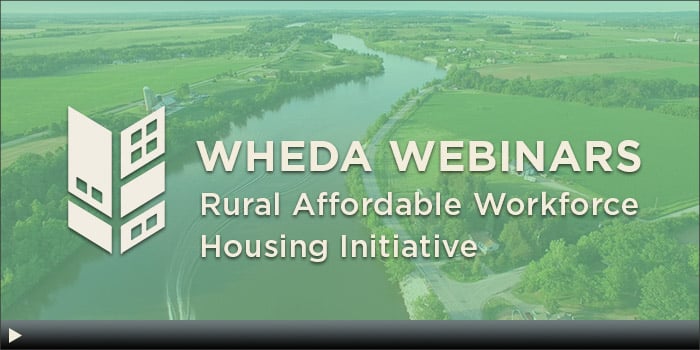WHEDA’s Rural Affordable Workforce Housing Initiative
The shortage of affordable workforce housing in rural Wisconsin poses far-reaching challenges. Access to safe, affordable shelter is fundamental to the sustainability of our communities because housing provides a foundation for public health, economic well-being, and environmental stewardship. If Wisconsin is to thrive, rural communities require effective tools and support to develop additional workforce housing.
A holistic approach to affordable workforce housing in rural communities
WHEDA’s Rural Affordable Workforce Housing Initiative (RAWFHI) represents an effort to identify possible solutions to remove barriers to the development and rehabilitation of workforce housing, and to create scalable solutions for rural communities across Wisconsin. The initiative, funded in part through WHEDA’s $16.7 million 2019-20 Dividends for Wisconsin plan and other reserves, totaled $10 million and includes three parts:
Project Timeline
October 2019
Assembly Bill 544 (AB 544) was introduced requiring WHEDA to set aside $10 million to address rural affordable workforce housing development concerns.
December 2019
May 2020
Funding was committed through the amended Dividends for Wisconsin plan, which was then approved by the Joint Committee on Finance.
May 2020
WHEDA established the Multifamily Rural Affordable Workforce Initiative Loan fund and allocated $2.25 million.
October 20, 2020
Finalist communities are announced by WHEDA for the Rural Affordable Workforce Housing Initiative pilot.
December 18, 2020 – June 2021
The Door County team worked collaboratively with community stakeholders to research, evaluate, and prioritize a set of key areas of need that impact local workforce housing. Challenges identified in Door County include public perception of affordable housing, zoning and land use policies, the increasing cost of development, and limited tools to finance infrastructure.
April 2021
WHEDA increased the amount of federal HTCs committed specifically to projects in rural communities from 15% to 25% of the overall allocation. WHEDA also established a 25% set-aside for rural projects in the state HTC program.
July 12 - December 20, 2021
The Marinette County pilot design was guided by information collected in a housing study completed in 2018. The pilot was focused on the concepts of positive community engagement, developer attraction, and rehabilitation of existing housing stock for further exploration and implementation.
March 2022
The Chequamegon Bay Pilot Design Team was introduced and began organizing work together and planning for community-based research on the local workforce housing affordability challenge.
Learn more about the pilot communities:
A continued effort to advance affordable rural workforce housing.
As the initiative continues, and once it has been completed in all three pilot communities, WHEDA will be able to collect a full spectrum of data, measure the outcomes, and deploy the learnings to advance affordable housing access and development across Wisconsin's many rural communities. Findings and recommendations from the RAWFHI pilot program are intended to be scaled to fit the needs of other rural communities within Wisconsin. A comprehensive report on the pilot projects will likely be released at the end of WHEDA's fiscal year in June 2023.
Learn more about the Rural Affordable Workforce Housing Initiative in the December 2022 report out here.
Watch our Webinars
Read project news releases
- Oct. 21, 2020 – Rural affordable workforce housing initiative moves forward with pilot communities, supplemental financing tools
- Aug. 5, 2020 - WHEDA updates application materials for rural affordable workforce housing initiative
- July 22, 2020 - WHEDA welcomes applications for rural affordable workforce housing initiative
- July 10, 2020 - Customer and community feedback leads to tax credit plan improvements
Frequently Asked Questions
Q: What is WHEDA’s Rural Affordable Workforce Housing Initiative?
A: WHEDA’s Rural Affordable Workforce Housing Initiative is a partnership-driven effort to address complex and evolving factors that are contributing to a shortage of affordable housing in rural Wisconsin. WHEDA has committed $10 million to the initiative, which includes:
- A pilot effort that will use adaptive, collaborative techniques to identify rural needs, evaluate choices, and implement scalable solutions; and
- Supplemental financing tools designed to overcome technical funding challenges and better serve rural communities throughout Wisconsin
Q: Why is the initiative needed?
A: If Wisconsin is to thrive, people need access to safe, affordable housing; employers need a skilled local workforce; and communities need housing and businesses for a healthy tax base. The current shortage of rural affordable workforce housing can be traced to many factors. Participants at a series of statewide listening sessions organized by WHEDA have pointed to rising construction costs; limited developer interest due to the smaller scale of rural projects; aging housing stock; few affordable rental options; zoning; infrastructure challenges; and limited financing for new construction and renovation projects.
Q: How is the project being funded and how will the funds be deployed?
A: WHEDA’s $10 million commitment to the Rural Affordable Workforce Housing Initiative is being funded through the amended 2019-20 Dividends for Wisconsin plan and other WHEDA resources. WHEDA is a public corporation that receives no state tax dollars for its work. While resources will be needed to organize and execute the rural affordable workforce housing pilots in at least three communities, it is WHEDA’s intent to also direct funding toward the statewide supplemental financing tools. WHEDA anticipates leveraging its sources of capital with funds from partners in the initiative.
Q: Why is collaboration needed?
A: Just as no single factor is responsible for the shortage of rural affordable workforce housing, no single entity will be able to address today’s challenges and the challenges that may arise in the future. Moreover, potentially necessary changes related to community priorities, policies, and practices require ideas and input from many voices. The participation of businesses, community leaders, housing providers, statewide associations, nonprofit groups, and community members will be critical for long-term success.
Q: How will you measure the outcomes?
A: WHEDA intends to develop metrics to evaluate the outcomes of the rural affordable workforce housing pilot and supplemental financing. These metrics will cover:
- Depth and breadth of engagement with partners;
- Extent of capacity building within the pilot communities;
- Reporting on applicability of solutions and development of a long-term rural housing strategy informed by the pilot;
- Generation of housing units and dollars invested in each pilot community; and
- Generation of housing units and dollars invested in rural Wisconsin
Ultimately, the initiative will help inform a long-term rural housing strategy that may involve WHEDA and its partners.
Q: My community doesn’t have a lot of staff and our leadership is volunteer-based. What kind of staffing needs or resources does my town need to be a part of your pilot?
A: The pilot process encourages communities to think broadly and reach out to collaborators that may have an interest in affordable housing as well as staff, professional expertise, and other support to contribute. In convening the effort, WHEDA’s role involves encouraging participation by statewide and non-traditional partners that have a stake in the economic health and well-being of rural Wisconsin. The application process itself allows for a broad definition of “community.” Cities, towns, villages, or others may take the lead in forming the application group as long as the USDA definition of rural is met. One critical element of the proposals will include the identification of someone to serve as a “convenor” or key point of contact for the effort.
Q: Do the pilot communities have access to financing sources that other communities will not?
A: The pilot communities likely will help test some tactics that require financing. WHEDA’s supplemental financing tools are intended for implementation statewide, and rural communities that are not selected for the pilot process also may benefit from rural set-asides identified in the 2021-22 plan for allocating federal and state low-income housing tax credits. In addition, successful tactics trialed through the pilot process ultimately will inform a statewide rural housing strategy. 3 Rev. 08.05.2020
Q: My community struggles with a specific issue (i.e., brownfields, blight, aging housing stock). How will the pilot and WHEDA help my community address these issues?
A: Every community is unique. The adaptive, collaborative approach of the pilot will support the identification of local priorities while the partners in each community will bring specific expertise. WHEDA’s contribution of financing expertise and the ability to engage statewide lending partners, state and federal policy makers, and regulatory agencies is anticipated to play a role in addressing challenges with solutions that lie outside the purview of local entities.
Q: What benefits do communities stand to receive by serving as a pilot community?
A: Pilot participants will benefit from a focused effort that brings external support, new partners, additional financing, transformative approaches, and the potential for policy changes to address local priorities.
Q: What does WHEDA mean by a “pilot design team,” and who should be on it?
A: The rural affordable workforce housing pilot effort will involve local individuals and entities working in partnership with WHEDA. This local pilot design team will feature a local convenor to help organize and elicit support from the community as well as track progress in coordination with WHEDA. In addition to someone in the “convenor” role, the pilot design teams should include members who bring an overall combination of energy, curiosity, technical expertise, decision-making power, and capacity to work collaboratively on hands-on projects. The team should reflect diverse industries, community entities, and sectors affected by the workforce housing challenge. Local nonprofits, foundations, developers, landowners, planners, and other community administration staff may provide important perspectives.




